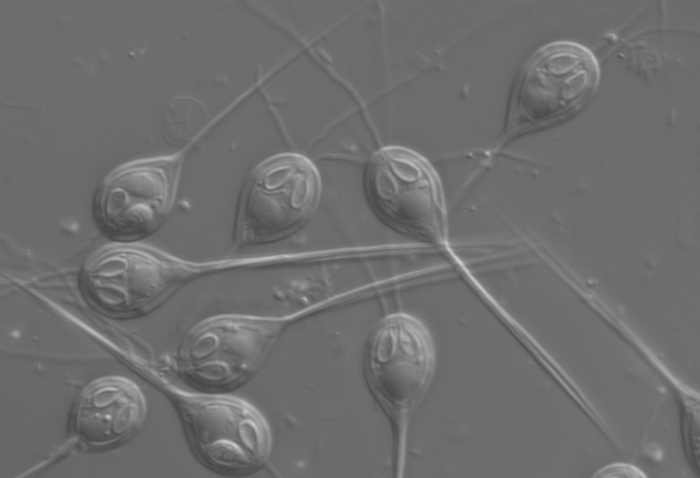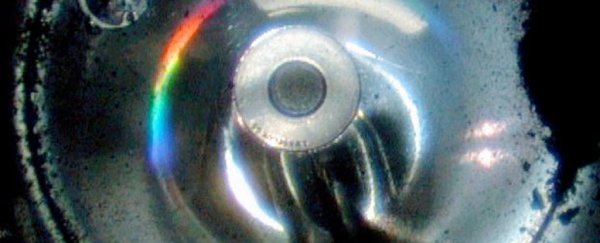With just a handful of days left in this strange beast of a year that will most certainly go down in history books, we thought it would be nice to reflect on the marvellous things scientists still delivered, despite everything.
Of course, scientific achievements are usually years in the making. Nevertheless, here's a round-up of some of the exciting science news we reported in 2020. Just to remember that it wasn't all terrible.
1. We found the first known extraterrestrial protein in a meteorite
Could life emerge elsewhere in the Solar System? As curious and intelligent beings, humans are naturally interested in finding out if living creatures thrive beyond the confines of our little blue space rock. One way to discover this requires turning to meteorites.
Earlier this year, scientists revealed they had found the first-ever extraterrestrial protein, tucked inside a meteorite that fell to Earth 30 years ago.
"We're pretty sure that proteins are likely to exist in space," astronomer Chenoa Tremblay told ScienceAlert in March. "But if we can actually start finding evidence of their existence, and what some of the structures and the common structures might be, I think that's really interesting and exciting."
2. We avoided some troubling changes in the atmosphere
A new study revealed that the famed Montreal Protocol - the 1987 agreement to stop producing ozone-depleting substances - could be responsible for pausing, or even reversing, some troubling changes in air currents around our planet's Southern Hemisphere.
Healing the protective ozone layer surrounding Earth seems to have paused the migration of an air current known as the southern jet stream, a phenomenon that ended up pushing parts of Australia into prolonged drought.
"If the ozone layer is recovering, and the circulation is moving north, that's good news on two fronts," explained chemist Ian Rae from the University of Melbourne.
3. An AI solved a 50-year-old biology challenge, decades before anyone expected
Earlier this month, scientists at the UK-based artificial intelligence company DeepMind announced that a new AI system had effectively solved a long-standing and incredibly complex scientific problem concerning the structure and behaviour of proteins.
For about 50 years, researchers have strived to predict how proteins achieve their three-dimensional structure. The astronomical number of potential configurations has made this task - known as the protein-folding problem - incredibly difficult.
DeepMind's success means a huge step forward in a range of research endeavours, from disease modelling and drug discovery, to applications far beyond health research.
4. Scientists used fast radio bursts to find the Universe's missing matter
In a mesmerising tale of mystery within a mystery, earlier this year a really clever application of fast radio burst ( FRB) tracing gave astronomers an answer to a perplexing question - just where is the missing matter in the Universe?
We're not talking about dark matter here, but the baryonic (normal) matter that should be there on account of all our calculations, but simply couldn't be detected until now. The Universe is vast, and the stretches between galaxies enormous. Yet in that seemingly empty space, lone atoms are still kicking around.
While looking for the source of the powerful interstellar signals known as FRBs, researchers figured out that extremely diffuse gas can account for all the missing 'normal' matter in the Universe. Phew.
5. We also confirmed the first-ever detection of an FRB in our own galaxy
That's right. On 28 April 2020, a Milky Way magnetar called SGR 1935+2154 flared up in a single, millisecond-long burst so incredibly bright, it would have been detectable from another galaxy.
This landmark detection made a huge and immediate impact on the study of mysterious FRBs, that until now had only been detected coming from outside our galaxy, making their precise source difficult to pin down.
"This sort of, in most people's minds, settles the origin of FRBs as coming from magnetars," astronomer Shrinivas Kulkarni of Caltech told ScienceAlert.
Astronomers had a whale of a time doing follow-up work on this detection, and by November we also had confirmation that this intra-galactic FRB is a repeater. We can expect even more excitement around this next year, for sure.
6. SpaceX and NASA made history with the first crewed launch
Space enthusiasts truly had lots of cause for excitement this year, as various launches and space missions soldiered on despite the global pandemic. On 30 May 2020, SpaceX became the first private space company to deliver NASA astronauts to the International Space Station (ISS).
We have liftoff. History is made as @NASA_Astronauts launch from @NASAKennedy for the first time in nine years on the @SpaceX Crew Dragon: pic.twitter.com/alX1t1JBAt
— NASA (@NASA) May 30, 2020
Not only did they safely bring them home several months later, another crewed launch went off without a hitch in November, delivering four astronauts to the space station - the first in what will likely be many routine missions in 2021 and beyond.
7. NASA touched an asteroid, and JAXA brought back a sample
After a long trip of more than 320 million kilometres (200 million miles), NASA's OSIRIS-REx spacecraft finally touched down on asteroid Bennu in October, collecting a sample of its surface rubble, its efforts captured for posterity in magnificent footage delivered by the space agency. We can expect the probe to return with its precious cargo in 2023.
Last year, the Japanese space agency JAXA achieved a similar feat with the Hayabusa2 probe, collecting a sample from asteroid Ryugu. In December this year, we witnessed the safe return of that sample, and have already been treated to a first glimpse of some of the black dust the team retrieved. We can't wait to learn more about what these asteroid missions will discover.
 Ryugu dust on the outside chamber of the retrieval capsule. (JAXA)
Ryugu dust on the outside chamber of the retrieval capsule. (JAXA)
8. Scientists found the first animal that doesn't need oxygen to survive
Back here on our own world, biologists were in for a surprise when they found the first multicellular organism without a mitochondrial genome - which means an organism that doesn't breathe. In fact, it lives without any need for oxygen at all.
While some single-celled organisms are known to thrive perfectly well in anaerobic conditions, the fact this common salmon parasite, a jellyfish-like creature Henneguya salminicola, doesn't need oxygen to survive is quite remarkable, and has left researchers with many new questions to answer.
 H. salminicola under the microscope. (Stephen Douglas Atkinson)
H. salminicola under the microscope. (Stephen Douglas Atkinson)
9. We got spectacular footage of a "long stringy stingy thingy" off the coast of Australia
Back in April, a trailing ribbon of conjoined tentacled clones caused quite a stir amongst a bunch of biologists exploring a little-studied part of the ocean off the coast of Western Australia. This strange entity was a particularly long siphonophore, a floating string of thousands of individual zooids. In fact, it could be one of the longest such strings ever observed.
Check out this beautiful *giant* siphonophore Apolemia recorded on #NingalooCanyons expedition. It seems likely that this specimen is the largest ever recorded, and in strange UFO-like feeding posture. Thanks @Caseywdunn for info @wamuseum @GeoscienceAus @CurtinUni @Scripps_Ocean pic.twitter.com/QirkIWDu6S
— Schmidt Ocean (@SchmidtOcean) April 6, 2020
"Everyone was blown away when it came into view," biologists Nerida Wilson and Lisa Kirkendale from the Western Australian Museum told ScienceAlert.
"There was a lot of excitement. People came pouring into the control room from all over the ship. Siphonophores are commonly seen but this one was both large and unusual-looking."
10. A physicist came up with the mathematics that makes 'paradox-free' time travel plausible
Wouldn't it be great to pop into a time-machine and fix up some mishap you've done in your past, all without accidentally killing your grandfather in the process?
Well, 2020 also became the year when we learned of a mathematically sound solution to time travel that doesn't muck everything up. Physics student Germain Tobar from the University of Queensland in Australia worked out how to "square the numbers" to make time travel viable without the paradoxes.
While it hasn't gotten us immediately closer to having a working time machine, his calculations show that space-time can potentially adapt itself to avoid paradoxes. And, according to Tobar's supervisor, the mathematics checks out. Fabulous.
11. The first COVID-19 vaccines are already being administered outside of clinical trials
The single biggest challenge the world faced this year was the global COVID-19 pandemic. Healthcare professionals and essential workers have carried much of the burden of keeping society afloat, and we can never thank them enough. Meanwhile, researchers from myriad relevant fields - from immunology to genetics - have also worked tirelessly all year long to better understand the novel coronavirus SARS-CoV-2.
That work will continue into the new year, but in late November we finally got the first taste of what it means to accelerate scientific research and funding beyond its typical pace. The very first vaccines intended to protect people from COVID-19 have already completed all the necessary phases of clinical trials, and are being rolled out in the UK, US, and parts or Europe.
Lots more will need to be done before we can put this devastating pandemic behind us and protect the most vulnerable communities worldwide, but already having effective vaccines is a truly fantastic achievement, and without a doubt the biggest cause for celebration of science this year. One to carry us into 2021 full of hope.
